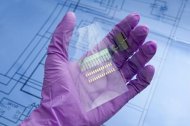 At the famed Palo Alto Research Center (PARC), scientists are making printable electronics a reality. PARC's printed logic circuits can drive printed memory manufactured by Thinfilm Electronics. PARC and Thinfilm Electronics
At the famed Palo Alto Research Center (PARC), scientists are making printable electronics a reality. PARC's printed logic circuits can drive printed memory manufactured by Thinfilm Electronics. PARC and Thinfilm Electronics
PALO ALTO, Calif. -- Got a large roll-to-roll printer that you're not sure what to do with? You might have a future in electronics manufacturing.
It's still very early days, but researchers at the Palo Alto Research Center (PARC) have been taking significant strides in developing a new technology that makes it possible to print electronic components like sensors, transistors, light-emitters, smart tags, flexible batteries, memory, smart labels, and more.
PARC's work can also bring a new element to 3D printing: adding electronic, sensing or optical functionalities to parts. Printing electronics shares one major trait with that very hot technology: It is additive rather than subtractive. That means, said Janos Veres, PARC's program manager for printed electronics, that rather than etching the components out of other materials, the new system uses specially concocted inks to generate the electronics from scratch. Those inks may be composed of molecules, nanomaterials, and even tiny suspended silicon chips.
Though PARC is a division of Xerox, and often utilizes that company's decades of printing expertise, it is not developing the new technology for its parent. Rather, it is working in conjunction with private companies and academic institutions to try to break new ground in the field of printable, functional electronics. Ultimately, it is looking for partners with groundbreaking ideas on how to use the technology for functional products or prototypes. That means that the sky is pretty much the limit for what's possible. All that's required is imagination, Veres said.
At the core of Veres' work is a blending of material science and printing technologies. And that means developing a series of special inks that incorporate the desired functionality, be it sensing, light-emitting, or even chips. "You make inks and print with those inks, " Veres explained. "And you only put it where you need it."
PARC is a fabled research institution, home to the very first graphical user interface, the first laser printer, and many other notable technological breakthroughs. And deep in its narrow hallways is Veres' lab, where he has a prototype electronics printer. Like others that are being developed in the field, this one features different print heads, each of which is used for making a different component. The idea, he said, is to be able to print an entire electronics assembly at once, with each head doing a different part of the job.
But while one method for printing electronics employs traditional InkJet print heads, other methods, such as gravure, and flexo, are being used as well.









